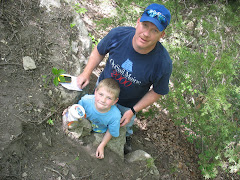

Yesterday Buggywasher and I spent several hours working on a new cache that we're placing. It's multistage puzzle cache. What this means is a cacher will have to drive to several cemeteries within the area. Then, using grid coordinates and clues will have to figure out the final cache site. We drove about 85 miles checking and double checking our coordinates and clues. And these pictures...well, they are not part of the cache and will not help in figuring out the puzzle! :)
After the 5th cemetery, I asked Jacob if he was creeped out by being in so many cemeteries. He told me he wasn't creeped out...only that one time when we were in a cemetery just after dark grabbing that last cache of the day and there was...well, that's a story for another day. I explained to him that not many kids and families go tromping through cemeteries...only geocachers! He didn't see anything wrong or spooky about visiting so many cemeteries. In fact, he told me that he kind of likes them...
So...our new cache we're setting has to do with certain tombstones. W.O.W tombstones. Woodmen of the World. I had never seen tombstones like this before! Each one is different...some are simple, others are very intricate. Some are small, others are more than 6 feet! I started taking pictures of these W.O.W tombstones while geocaching. They are amazing! Every time we're in a cemetery, we are always on the lookout for tree stumps!
Here is a little history about Woodmen of the World, otherwise known as Modern Woodmen today.
In 1883, a man by the name of Joseph Cullen Root organized a fraternal society in Omaha, Nebraska, called "Modern Woodmen of America". One of the benefits of being a member was that upon death, the other members would pass around a hat and donate money to the widow. Membership was limited to white males older than 18 years of age. Later when passing around the hat became more frequent and costly, Root decided to sell life insurance to members. Modern Woodmen of America became a fraternal benefit society
The Name: In fact, it came from a church sermon founder Joseph Cullen Root heard as he was trying to choose a name for the fraternal benefit society he planned to organize. As he sat listening to the minister talk about "the work of the pioneer woodmen clearing away the forest," it occurred to him that this was a fitting analogy for the task of eliminating a man's financial burdens in the event of his death. Thus, Root chose Modern Woodmen for the name of his new benefit society. The phrase of America was added later to signify the group's patriotism
Later, a women's auxiliary started up called "Royal Neighbors of America. Both the male and female organizations grew steadily and in five years, Modern Woodmen had a total membership of twenty-four thousand.
In 1899, several members had a "falling out" with the leaders of the society, and separated to form a new society under the leadership of Fred A. Falkenburg, and named it "Woodmen of the World". Shortly after, tensions were high in the new organization, and Falkenburg moved to Denver to form, "Woodmen of the World, Pacific Jurisdiction". Today, the three societies remain as insurance companies. Woodmen of the World created women's auxiliaries called "Woodmen Circle" and "Supreme Forest Woodmen", while the Pacific Jurisdiction created an auxiliary called, "Neighbors of Woodcraft", which still exists as an insurance company in Portland, Oregon.
The traditional W.O.W. monument had 4 objects on it. They were the Maul, Axe, Wedge and the Dove. The motto Dum Tacet Clamat is Latin meaning "though silent, he speaks". This insurance company, started in the 1880's, would pay the widow $100 and a free stone if the logo of the insurance company could be put on the stone. Styles were very elaborate to very simple. As time passed, the stones got to be smaller and smaller until they were similar to the conventional styles. The cost of the hand made marble stones became prohibitive and they were finally phased out about 1920. These stones are a real eye catcher to the cemetery visitor or one who registers graves.
Here are some interesting websites about W.O.W.
Jim Davenport's Project
Modern Woodmen
Woodmen Group (great history)
Woodmen Burials











